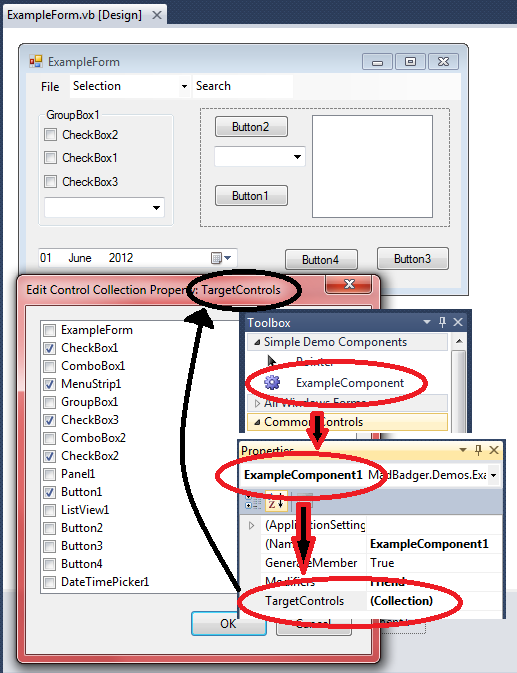Introduction
The point of the tip is about gaining access to the design time form from within a property editor (UITypeEditor) in Visual Studio using Visual Basic.
Notes on the download
- Don't try running the app, it doesn't do anything
- The point is that within the IDE, with the form designer open (
Simple Demo -> ExampleForm), you can select the component called ExampleComponent1 and then in the property editor, the TargetControls property is a collection and clicking on the ellipsis reveals the UITypeEditor - You can note that the controls that are selected (or not) are persisted between IDE sessions which means that when you build your app, the collection will be visible at run time
I was creating a Visual Studio property editor (UITypeEditor) for a .NET component that holds a subset of the controls on the form to which it is attached at design time. Initially, I had great difficulty working out how to do that but as usual, once you discover the answer, it turns out to be pretty easy.
The image below shows a demo application using the custom UITypeEditor. There's a custom component with a property, called TargetControls, which uses that custom UITypeEditor. The actual property editor itself is the form bottom left (red border) and as you can see, it contains a list of the controls on the form shown at the top. The image is from within Visual Studio, not in debugging mode, so that's the form designer you can see at the top.

Background
It's pretty easy to create a Collection(Of Control) at run-time, where the Controls in the Collection are the Controls on the Form. It's notably more difficult to do this at design time - and that's what I needed to do, so I created a UITypeEditor that can populate a Component or Control property with one or more of the Controls on a form at design time. I used the Creating Property Editors in DesignTime for VS.Net Easily (UITypeEditor Helper) article by S.Serpooshan to provide the base class.
Here, I will reproduce only the part of the code for retrieving the list of Controls on the form since the full class will (hopefully) be the subject of an article rather than a tip.
Using the Code
Within a UITypeEditor, there is a method called EditValue, whose job is to display the custom control (a dropdown or a modal form) and update the property dependent on how the user interacts with the control. I've removed all the surrounding code that loads and shows the custom control and the code that manages updating the property in order to focus the tip on the interesting bit. All the other stuff you can get from S. Serpooshan's article.
myControl is a reference to the custom property editor control, which in this case is a form with a CheckedListBox (the name of which is AvailableControls).
The first For Each loop adds items to that CheckedListBox having accessed a reference to the design time form through the context parameter of the EditValue function. Working out that this parameter gives you a way to reference the design time form was the key, it's pretty easy from there.
The second For Each loop simply determines which items in the CheckedListBox to check before displaying it, i.e., those that are held in the current value of the property before the user gets a chance to edit it.
Public Overrides Function EditValue(ByVal context As ITypeDescriptorContext, _
ByVal provider As IServiceProvider, ByVal value As Object) As Object
...
...
For Each c As Component In context.Container.Components
If TypeOf c Is Control Then
myControl.AvailableControls.Items.Add(c)
End If
Next
If value IsNot Nothing Then
Dim tCollection As Collection(Of Control) = CType(value, Collection(Of Control))
Dim found As Integer
For Each c As Control In tCollection
found = myControl.AvailableControls.Items.IndexOf(c)
If Not found = -1 Then
myControl.AvailableControls.SetItemChecked(found, True)
End If
Next
End If
...
...
End Function
To use the code, you would create a custom component with a public property of type Collection(Of Control). You'd then set its EditorAttribute to the class name of the UITypeEditor.
Public Class ControlCollectionUITypeEditor
Inherits UITypeEditor
...
...
End Class
Public Class ExampleComponent
Inherits Component
Private _TargetControls As New Collection(Of Control)
<EditorAttribute(GetType(ControlCollectionUITypeEditor), _
GetType(System.Drawing.Design.UITypeEditor))>
<DesignerSerializationVisibility(DesignerSerializationVisibility.Content)>
Public Property TargetControls As Collection(Of Control)
Get
Return _TargetControls
End Get
Set(ByVal value As Collection(Of Control))
_TargetControls = value
End Set
End Property
End Class
Points of Interest
I went around the houses on this with a couple of folks at the MSDN Visual Basic General forum, the main thrust of which is 'you can't do it'.
You can if you try hard enough!
History
- Version 1: Original tip
- Version 2: Added download per answer to question 29 October 2013
 General
General  News
News  Suggestion
Suggestion  Question
Question  Bug
Bug  Answer
Answer  Joke
Joke  Praise
Praise  Rant
Rant  Admin
Admin 







